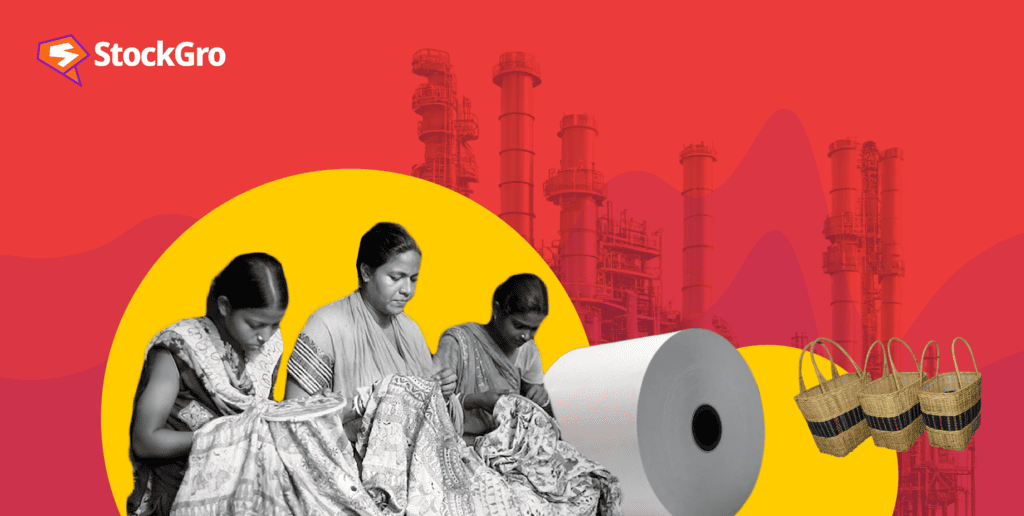
Table of contents
Large corporations and multinationals are most often credited for the country’s growth and progress. But do you know that there is a whole sector of small enterprises working hard to contribute to the economy’s development?
Often called the spine of the economy, the MSME sector contributes significantly towards the economy by running businesses in various sectors. In this article, we will learn what the MSME sector is and how it has grown over time.
What does the MSME sector in India consist of?
Businesses are classified as MSMEs based on their turnovers. Businesses from all sectors fall under this category with few exceptions, like gambling, betting, forestry, domestic personnel, etc.
As per the new rules of the MSME Act, businesses fall under this category if they meet the following requirements:
| Category | Investment in plant, machinery or equipment | Annual turnover |
| Micro enterprise | < ₹1 crore | < ₹5 crore |
| Small enterprise | < ₹10 crore | < ₹50 crore |
| Medium enterprise | < ₹50 crore | < ₹250 crore |
The Ministry of Micro, Small and Medium Enterprises, formed under the Government of India, regulates the activities of businesses in the MSME sector. Mr Narayan Rane heads the ministry, and the MSME sector has an annual budget of ₹22,138 crore for 2023-24.
History and growth of small and medium enterprises in India
The term MSME may have been coined recently. However, the existence of micro, small, and medium industries can be seen even before the British era. Agriculture, handlooms, handicrafts and various other cottage industries existed in the pre-British and pre-independence eras.
Also read: Textile industry in India – The foundation of fashionable clothing trendsps
Known by ‘Village and Small Industries’, ‘Tiny Industries’, and other different terms, the sector did not get enough focus and recognition until the 1990s.
As the country grew and transformed, the government began focusing on small-scale industries to provide a facilitative environment for their operations. In 1999, the Ministry of Small-Scale Industries and Agro and Rural Industries was established. In 2001, it was split into two: the Ministry of Small-Scale Industries and the Ministry of Agro and Rural Industries.
Later, in 2006, the government of India merged the different ministries and regulations into one and named the sector ‘Micro, Small and Medium Enterprises’, which continues to exist today.
| MSME category | Number of MSMEs registered in FY 22 (In Lakhs |
| Micro | 2.93 lakhs (5%) |
| Small | 0.32 lakhs (1%) |
| Medium | 54.41 lakhs (94%) |
Indian micro and small-scale industries today
Today, businesses falling under the MSME category contribute significantly to the country’s GDP, employment and entrepreneurship development among citizens.
- Nearly one-third of the country’s GDP comes from the MSME sector. As of 2021-22, 29.2% is the contribution of MSME to the GDP of India.
- Of the total manufacturing outputs in the country, 36.2% was produced by the MSME sector in 2021-22.
- The MSME sector also has a prominent role in the country’s exports. 2020-21 had nearly half of the country’s exports from MSMEs. As of 2022-23, 43.6% of export products and services were from MSMEs.
- As of August 2023, the MSME units established in the last three years employed over 12 crore workers across different industries.
- The country currently has about 6.3 crore MSME units, and the number is expected to go up to 7.5 crores soon.
Government initiatives
The government and statutory bodies under the MSME ministry have initiated various schemes to support and develop the working environment in the MSME sector. Some of them are:
- Udhyog Aadhar Memorandum – UAM is a one-page registration portal introduced by the government for easy registration as an MSME. The portal requires self-certification with no documents, making online registration convenient.
- Pradhan Mantri MUDRA Yojana (PMMY) – MUDRA stands for Micro Units Development and Refinance Agency. The scheme was launched by the Prime Minister in 2015 to provide loans up to ₹10 lakhs for non-corporate and non-farm SMEs. In FY 2022-23, the scheme sanctioned over 6.2 crore loans with more than ₹4.5 lakh crores disbursed.
- Prime Minister’s Employment Generation Programme – Khadi and Village Industries Commission (KVIC), one of the statutory bodies of MSME aims to generate employment in rural areas by setting up new MSMEs. From 2009 to 2022, the scheme has provided subsidies of ₹19,995 crore and jobs to over 64 lakh workers.
- Credit Linked Capital Subsidy Scheme – Given the low cost of budget and capital available for running the business, most MSMEs do not have access to the latest technology. The government, under this scheme, provides a capital subsidy of 15% up to ₹15 lakhs for MSMEs to move out of outdated technology and invest in the latest ones.
- Credit Guarantee Trust Fund for Micro and Small Enterprises – This scheme aims to provide collateral-free loans to businesses in the MSME sector. Until June 2023, the trust has provided loans worth ₹4,50,163 crore.
- Entrepreneurship and Skill Development Programmes (ESDP) – This is an initiative by the Indian government to develop the skills required in youth to be entrepreneurs and establish their business ventures.
- Financial support to MSMEs in ZED certification – Zero Defect and Zero Effect is a certification for MSMEs to meet the required quality standards and adapt good quality tools to produce zero defect products which do not impact the environment.
Also read: Fueling India’s growth engine: Evolution and outlook of oil & gas industry
Recent developments in micro and small-scale industries
Various corporates and banks have been tying up with the government to provide facilities for the development of businesses in the MSME sector. Some of those initiatives are:
- Public Tech Platform for Frictionless Credit (PTPFC) – Announced in August 2023, this is a pilot project by the innovation hub of the RBI, to connect borrowers and lenders seamlessly through an online platform.
- In August 2023, Flipkart partnered with the government of Gujarat under the Flipkart Samarth program to help local businesses digitise their operations.
- In May 2022, Aditya Birla Capital launched Udyog Plus, an online portal to provide hassle-free capital, investment solutions, advisory services and more to businesses in the MSME sector.
- In May 2023, Max Life announced its tie-up with the Indian Industries Association, a representative of MSME, to provide life insurance for MSME employees in Uttar Pradesh.
- In October 2021, Sundaram Finance and MSME Development Institute in Chennai, came together to provide marketing assistance to MSME businesses, along with developing entrepreneurial and managerial skills.
MSME companies list
Siyaram Recycling Industries Limited, an SME that went public recently had an IPO issue of ₹22.96 crores. The IPO was oversubscribed 385.19 times, showing the growth of the MSME sector and the increasing interest of investors towards this industry.
Below are some upcoming IPOs in the MSME sector:
| Company | IPO Dates | Issue price |
| Kay Cee Energy & Infra Limited IPO | 28 Dec 2023 – 02 Jan 2024 | ₹51 to ₹54 |
| Shri Balaji Valve Components Limited IPO | 27 Dec 2023 – 29 Dec 2023 | ₹95 to ₹100 |
| AIK Pipes And Polymers Limited IPO | 26 Dec 2023 – 28 Dec 2023 | ₹89 |
| Sameera Agro And Infra Limited IPO | 21 Dec 2023 – 27 Dec 2023 | ₹180 |
| Trident Techlabs Limited IPO | 21 Dec 2023 – 26 Dec 2023 | ₹33 – ₹35 |
| Supreme Power Equipment Limited IPO | 21 Dec 2023 – 26 Dec 2023 | ₹61 – ₹65 |
| Indifra Limited IPO | 21 Dec 2023 – 26 Dec 2023 | ₹65 |
There are numerous MSMEs across the country. Below are some well-known companies:
- Olimax Systems Pvt Ltd – Established in 2010, the company has its products in the Industrial Engineering sector and is headquartered in Pune. The company has an annual revenue between ₹25-50 crores, of which 40-60% comes from exports.
- Assam Carbon Products Ltd – The company has been manufacturing carbon-related products, since its inception in 1963. Headquartered in Guwahati, Assam, it has over 350 employees working across India.
- Minimac Systems Pvt Ltd – Established in 2012 and headquartered in Mumbai, Minimac is a company running its business in lubrication management. The company reached the million-dollar club in 2016 and has its footprints in different countries.
- Emkay Taps and Cutting Tools Ltd – Headquartered in Maharashtra, Emkay runs its business in the industrial engineering sector. The company is listed on the National Stock Exchange and closed at ₹615 on Dec 15, 2023.
- Shiva Granito Export Ltd – Established in 2007, the company engages in producing granite-based products. It is headquartered in Udaipur and is one of the large exporters of granite and marble. Shiva Granito is listed on BSE and had a share price of ₹10.4 on Dec 13, 2023.
Also Read: The healthcare industry in India: An overview
Bottomline
The MSME sector, which was overlooked for decades, is one of the largest contributors to the country’s economy today. Realising the potential, the government, along with various private and public sector organisations, have come up with schemes for the development of the MSME sector.
Looking at the current trend, MSME will undoubtedly continue to grow and provide employment to millions of workers across the country.

